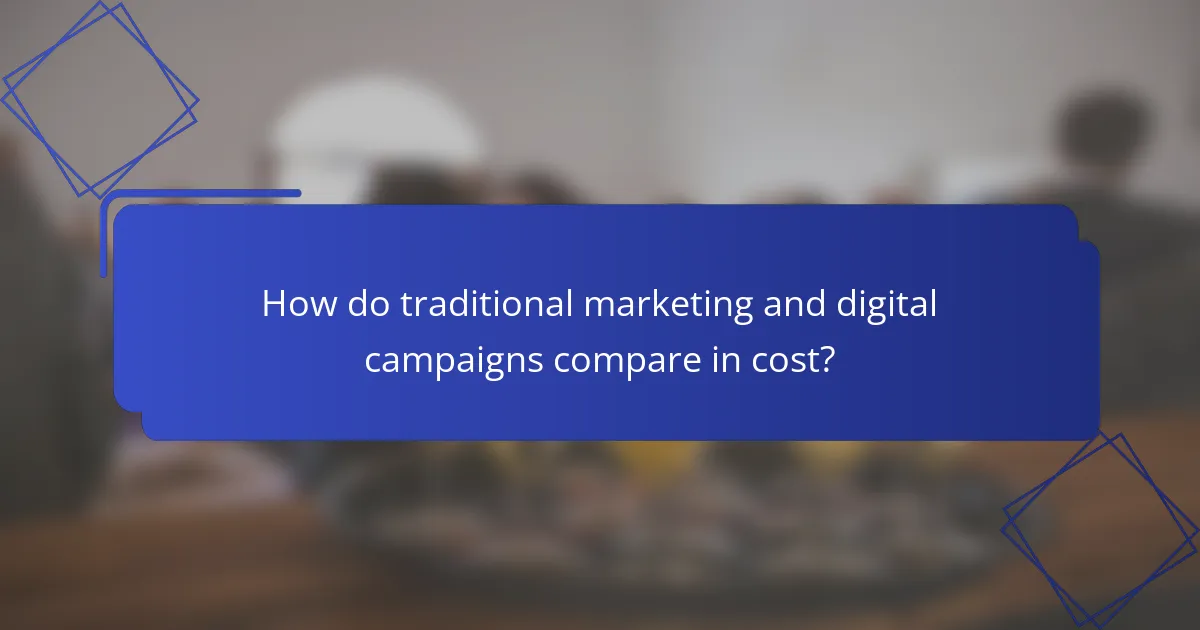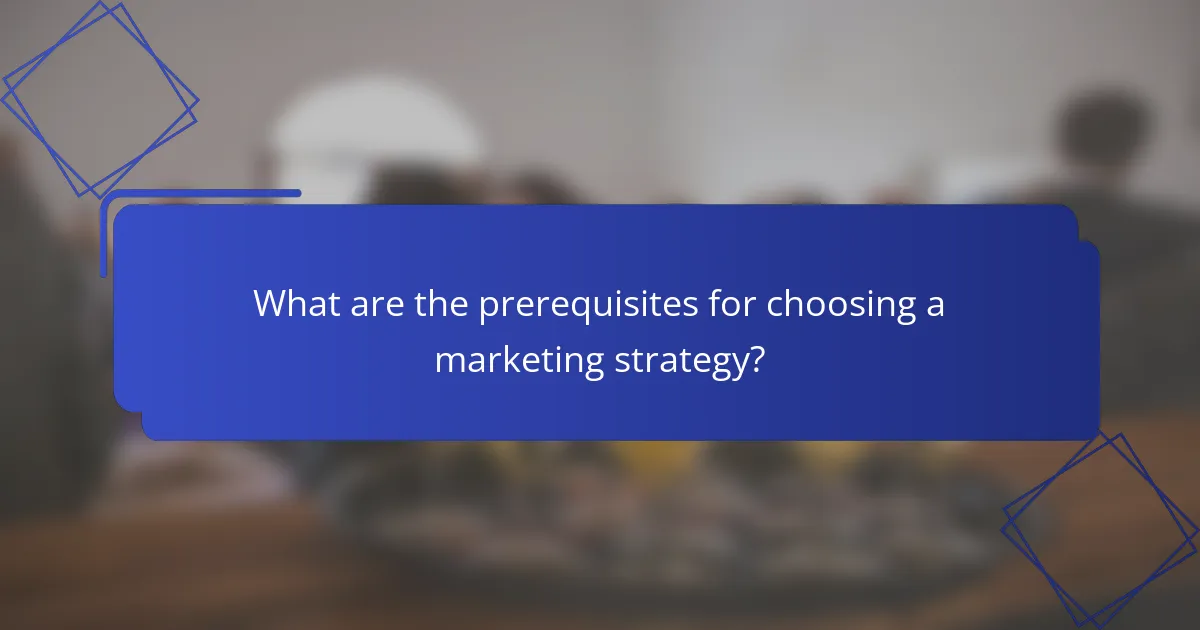In the ever-evolving landscape of marketing, businesses often find themselves weighing the benefits of traditional marketing against the advantages of digital campaigns. While traditional methods excel in creating personal connections and establishing credibility, digital strategies offer precise targeting and measurable results. Understanding when to utilize each approach is crucial for maximizing marketing effectiveness and reaching the desired audience.

What are the advantages of traditional marketing?
Traditional marketing offers several advantages, including tangible materials, personal interactions, and established credibility. These elements can effectively reach specific audiences and create lasting impressions.
Brand recognition through print media
Print media, such as brochures, flyers, and newspapers, can significantly enhance brand recognition. These physical materials allow potential customers to engage with your brand in a more direct way, often leading to higher recall rates compared to digital ads.
For instance, a well-placed advertisement in a local newspaper can effectively target a community, creating a sense of familiarity. Consider using high-quality visuals and consistent branding to strengthen your message.
Personal connection via face-to-face interactions
Face-to-face interactions foster personal connections that digital campaigns often lack. Events like trade shows, community fairs, or in-store promotions allow businesses to engage directly with customers, building relationships and trust.
Utilizing these opportunities can lead to immediate feedback and a better understanding of customer needs. Always prepare to listen actively and respond to inquiries to maximize these interactions.
Established trust with older demographics
Older demographics tend to have a stronger affinity for traditional marketing methods. Many in this group are more familiar with print and broadcast media, which can lead to a greater sense of trust in these formats compared to digital alternatives.
To effectively reach this audience, consider using familiar channels like newspapers, radio, and television. Tailoring your messaging to resonate with their values and preferences can enhance engagement and loyalty.

What are the advantages of digital campaigns?
Digital campaigns offer several advantages, including enhanced targeting, real-time performance tracking, and cost-effectiveness compared to traditional marketing methods. These benefits make digital strategies particularly appealing for businesses looking to maximize their marketing impact.
Targeted audience reach through social media
Digital campaigns excel in reaching specific audiences through social media platforms like Facebook, Instagram, and LinkedIn. Advertisers can use demographic data, interests, and behaviors to tailor their messages, ensuring they connect with the right people.
For example, a local coffee shop can target ads to users within a certain radius who have shown interest in coffee or local events. This targeted approach often results in higher engagement rates and conversion potential.
Real-time analytics for performance tracking
One of the key advantages of digital campaigns is the ability to track performance in real-time. Marketers can access metrics such as click-through rates, engagement levels, and conversion rates almost instantly, allowing for quick adjustments to strategies.
This immediate feedback loop helps businesses identify what works and what doesn’t, enabling them to optimize their campaigns on the fly. For instance, if an ad isn’t performing well, marketers can modify the content or targeting parameters without waiting for a lengthy reporting period.
Cost-effectiveness compared to traditional methods
Digital campaigns are generally more cost-effective than traditional marketing methods like print or television advertising. With options ranging from pay-per-click to social media ads, businesses can choose budgets that fit their financial constraints while still reaching a broad audience.
For instance, small businesses can start with modest budgets, often as low as a few dollars a day, and scale up based on performance. This flexibility allows for better allocation of marketing resources and minimizes waste.

When should businesses use traditional marketing?
Businesses should consider traditional marketing when they aim to reach local audiences, engage with older demographics, or build long-term brand loyalty. These strategies can be particularly effective in environments where digital penetration is lower or where personal connections are highly valued.
Local events and community engagement
Traditional marketing shines in local events and community engagement efforts. Sponsoring local sports teams, hosting community fairs, or participating in farmers’ markets can foster strong connections with nearby consumers. These face-to-face interactions often lead to higher trust and brand recognition.
Consider using flyers, posters, or local radio ads to promote events. These methods can effectively reach residents who may not be active online, ensuring your message resonates within the community.
Targeting older audiences
Older audiences often respond better to traditional marketing channels. Many individuals in this demographic prefer print media, television, and radio over digital platforms. Therefore, businesses should tailor their marketing strategies to include these formats when targeting this age group.
Using direct mail campaigns or newspaper advertisements can be particularly effective. Ensure that the messaging is clear and relatable, as older consumers appreciate straightforward communication.
Building brand loyalty over time
Traditional marketing can be instrumental in building brand loyalty over time. Consistent exposure through print ads, billboards, and community sponsorships helps reinforce brand recognition and trust. This long-term approach often leads to repeat customers who feel a connection to the brand.
To enhance loyalty, consider loyalty programs promoted through traditional channels. Offering discounts or rewards for repeat purchases can encourage ongoing engagement and strengthen customer relationships.

When should businesses use digital campaigns?
Businesses should consider digital campaigns when they aim to reach a wide audience quickly and effectively. Digital marketing offers flexibility, allowing for targeted messaging and real-time engagement, making it ideal for various marketing goals.
Launching new products to a broad audience
Digital campaigns are particularly effective for launching new products because they can reach diverse consumer segments across multiple platforms. Utilizing social media, email marketing, and online ads enables businesses to generate buzz and attract attention rapidly.
For instance, a company might use Facebook and Instagram ads to showcase a new product, targeting specific demographics based on interests and behaviors. This approach can lead to higher visibility and quicker sales compared to traditional methods.
Engaging younger demographics
Younger consumers, particularly those in the millennial and Gen Z age groups, are more likely to engage with brands through digital channels. Businesses should leverage platforms like TikTok, Snapchat, and Instagram, where these demographics spend significant time.
Creating interactive content, such as polls, quizzes, or short videos, can enhance engagement and foster brand loyalty. Brands that effectively use influencers to promote products can also resonate well with younger audiences, driving both awareness and sales.
Measuring campaign effectiveness instantly
One of the key advantages of digital campaigns is the ability to measure effectiveness in real-time. Businesses can track metrics such as click-through rates, conversion rates, and engagement levels almost immediately after launching a campaign.
Using tools like Google Analytics or social media insights allows for quick adjustments based on performance data. This agility helps businesses optimize their strategies, ensuring they allocate resources effectively and maximize return on investment.

How do traditional marketing and digital campaigns compare in cost?
Traditional marketing typically incurs higher upfront costs compared to digital campaigns, which often have lower ongoing expenses. Understanding these cost dynamics is crucial for businesses deciding which approach to prioritize based on their budget and goals.
Higher upfront costs for traditional marketing
Traditional marketing methods, such as print ads, television commercials, and billboards, often require significant initial investments. For instance, producing a TV ad can cost thousands to millions of dollars, depending on the production quality and airtime. Additionally, costs for printing materials and purchasing ad space can add up quickly.
Businesses should consider the longevity of traditional marketing campaigns, as they may require a larger budget upfront but can yield long-term brand recognition. However, the return on investment (ROI) can be harder to measure compared to digital methods.
Lower ongoing costs for digital campaigns
Digital campaigns generally have lower ongoing costs, making them more accessible for small to medium-sized businesses. Platforms like social media and email marketing allow for targeted advertising with budgets that can start as low as a few dollars per day. This flexibility enables businesses to adjust their spending based on performance and audience engagement.
Moreover, digital marketing offers real-time analytics, allowing businesses to track ROI more effectively. This data-driven approach helps in optimizing campaigns without the hefty costs associated with traditional marketing methods.

What are the key metrics for evaluating campaign success?
Key metrics for evaluating campaign success include return on investment (ROI), customer engagement rates, and lead generation effectiveness. These metrics help determine the overall impact and efficiency of marketing strategies, guiding future decisions.
Return on investment (ROI)
ROI measures the profitability of a campaign by comparing the revenue generated to the costs incurred. A positive ROI indicates that the campaign is financially beneficial, while a negative ROI suggests a need for reevaluation. Generally, a good ROI for marketing campaigns ranges from 5:1 to 10:1, meaning for every dollar spent, five to ten dollars are earned.
To calculate ROI, use the formula: (Net Profit / Cost of Investment) x 100. This straightforward calculation allows marketers to assess the financial success of their campaigns quickly. Keep in mind that ROI can vary significantly across different channels, so it’s essential to compare similar campaigns for accurate insights.
Customer engagement rates
Customer engagement rates reflect how actively audiences interact with your marketing content, such as social media posts, emails, or advertisements. High engagement rates often indicate that your messaging resonates with the target audience, leading to increased brand loyalty and conversions. Typical engagement rates can range from 1% to 5% for email campaigns and higher for social media platforms.
To improve engagement, focus on creating relevant, high-quality content that encourages interaction. Techniques include asking questions, using compelling visuals, and personalizing messages. Regularly monitoring engagement metrics helps identify trends and adjust strategies accordingly.
Lead generation effectiveness
Lead generation effectiveness measures how well a campaign attracts potential customers and converts them into leads. This metric is crucial for understanding the quality of your marketing efforts and the likelihood of generating sales. A successful lead generation campaign typically converts around 2% to 5% of visitors into leads, depending on the industry and approach.
To enhance lead generation, employ tactics such as offering valuable content, utilizing clear calls-to-action, and optimizing landing pages for conversions. Tracking the source of leads can also help identify which channels are most effective, allowing for better allocation of resources in future campaigns.

What are the prerequisites for choosing a marketing strategy?
Choosing a marketing strategy requires understanding your target audience, budget, and goals. Assessing these factors helps determine whether traditional or digital campaigns are more suitable for your business needs.
Understanding your target audience
Identifying your target audience is crucial for selecting an effective marketing strategy. Consider demographics such as age, location, and interests. For instance, younger audiences may respond better to digital campaigns through social media, while older demographics might prefer traditional methods like print advertising.
Conducting market research can provide insights into audience preferences and behaviors. Surveys, focus groups, and analytics tools can help gather this information, allowing you to tailor your approach accordingly.
Budget considerations
Your budget significantly influences the choice between traditional and digital marketing. Traditional marketing methods, such as television and print ads, often require larger upfront investments. In contrast, digital campaigns can be more flexible, allowing for lower-cost options like social media ads or email marketing.
Evaluate your financial resources and consider allocating a portion of your budget for testing different strategies. This can help you identify which methods yield the best return on investment.
Defining your marketing goals
Clearly defined marketing goals guide your strategy selection. Whether you aim to increase brand awareness, generate leads, or drive sales, your objectives will dictate the most effective approach. For example, if your goal is immediate sales, digital campaigns with targeted ads may be more effective.
Establishing measurable goals, such as a specific percentage increase in sales or website traffic, can help assess the success of your chosen strategy. Regularly reviewing these goals allows for adjustments and optimization of your marketing efforts.



